Virginia, a Southern State of the United States, was the site of some of the most important events in American history. The first permanent English settlement in America was made at Jamestown in 1607. In 1619, the Jamestown colonists established the first representative legislature in America. Some of the greatest battles of the American Revolution and the American Civil War were fought in Virginia. American independence from Britain was assured when George Washington forced Lord Cornwallis to surrender at Yorktown, Virginia, in 1781. The Civil War essentially ended when Confederate forces surrendered at Appomattox, Virginia, in 1865.

Virginia was named for Queen Elizabeth I of England, who was known as the Virgin Queen. Historians think the English adventurer Sir Walter Raleigh suggested the name about 1584. That year, Elizabeth gave Raleigh permission to colonize the Virginia region.
Virginia is also known as the Old Dominion. King Charles II gave it this name because it remained loyal to the crown during the English Civil War of the mid-1600’s. Virginia is one of four states officially called commonwealths. The others are Kentucky, Massachusetts, and Pennsylvania.
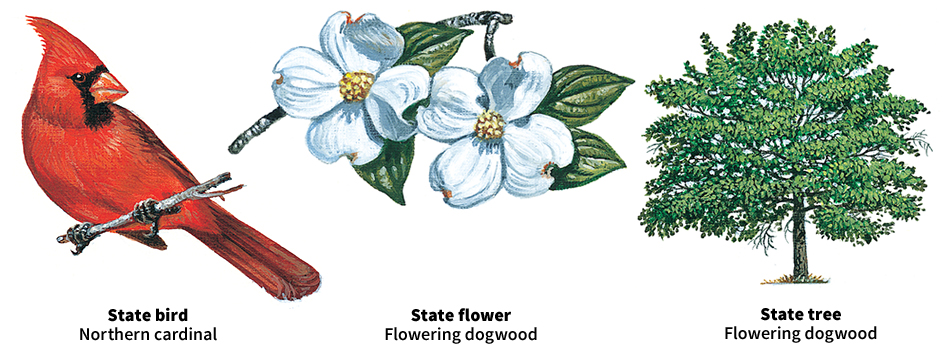
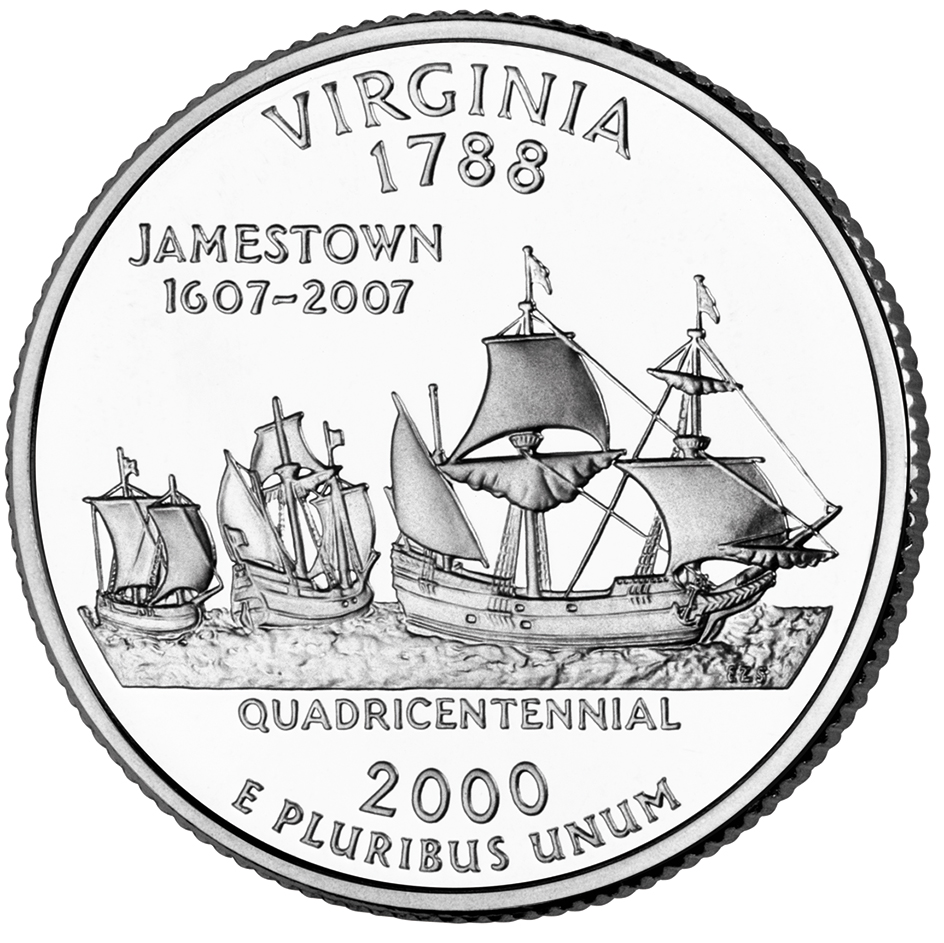
Virginia has the nickname Mother of Presidents because eight U.S. presidents were born there. They include four of the first five presidents—George Washington, Thomas Jefferson, James Madison, and James Monroe. Other presidents born in Virginia were William Henry Harrison, John Tyler, Zachary Taylor, and Woodrow Wilson.
Virginia also has the nickname Mother of States. All or part of eight other states were formed from western territory once claimed by Virginia. These states are Illinois, Indiana, Kentucky, Michigan, Minnesota, Ohio, West Virginia, and Wisconsin.
Tourists from all parts of the United States come to Virginia to see its battlefields, famous old churches, colonial homes, and other historic sites. Famous homes include George Washington’s Mount Vernon, Thomas Jefferson’s Monticello, and George Mason’s Gunston Hall. Mason was a Virginia statesman who wrote the Virginia Declaration of Rights, the first American bill of rights. The Tomb of the Unknowns and the grave of President John F. Kennedy are in Arlington National Cemetery. The cemetery surrounds the mansion of Civil War General Robert E. Lee and his wife, Mary Custis Lee. Williamsburg, Virginia’s second colonial capital, has been restored to look as it did in the 1700’s.
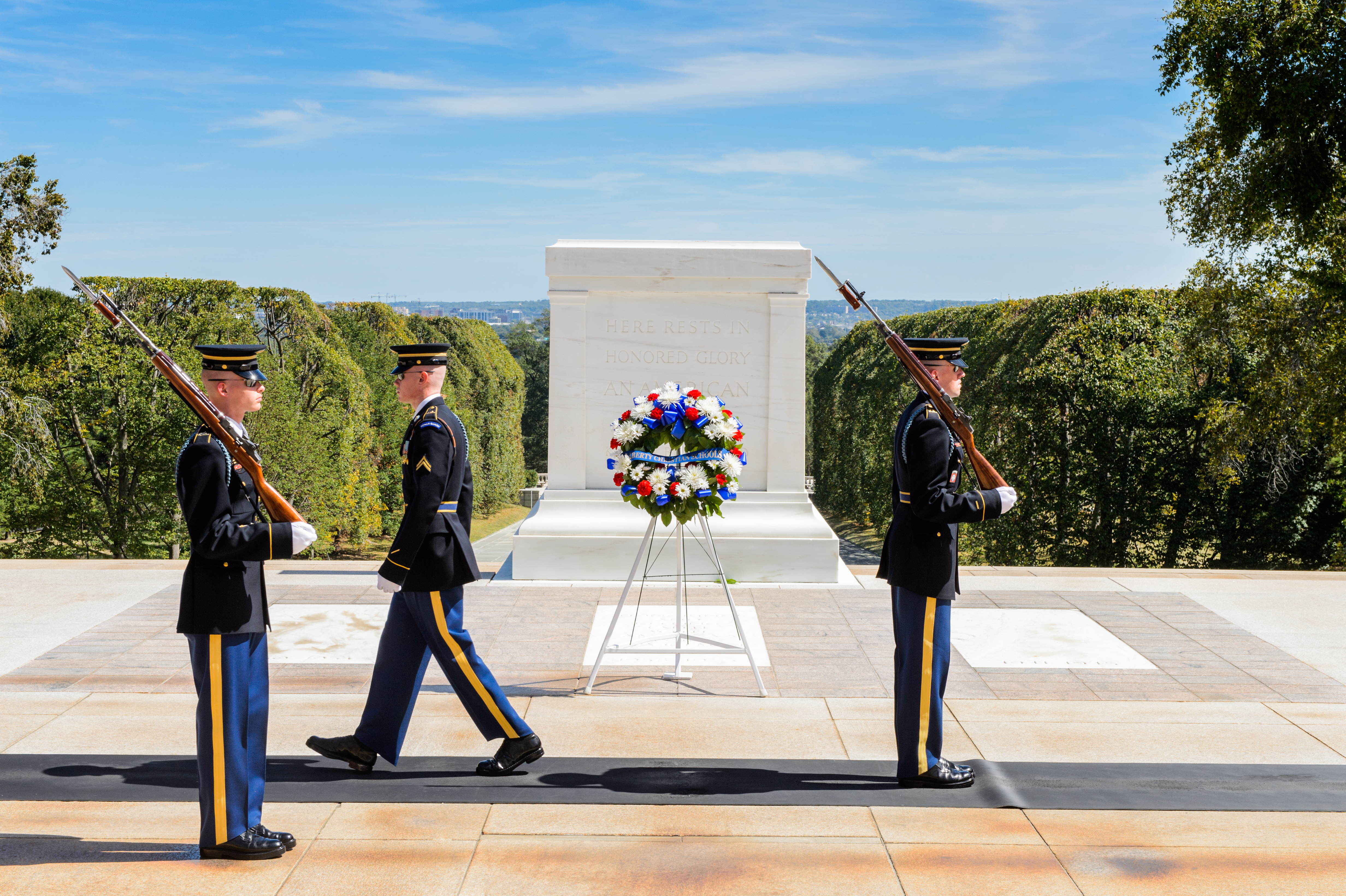
Many tourists also come to see Virginia’s beautiful scenery. The Skyline Drive along the top of the Blue Ridge offers spectacular views of the Shenandoah Valley. In this fertile valley, General Stonewall Jackson won victories over Union armies during the Civil War. Virginia’s natural wonders include the Natural Bridge, Natural Chimneys, Natural Tunnel, and many large caves.
Many agencies of the federal government have offices in northeastern Virginia, which lies next to Washington, D.C. These offices include the Pentagon and the headquarters of the Central Intelligence Agency. Virginia also has several military bases.
Virginia’s factories make chemicals, processed foods, tobacco products, transportation equipment, and many other products. Shipyards in the Hampton Roads area build ships for the U.S. Navy and for commercial use. Broilers (young, tender chickens) are the leading farm product. Coal is the leading mineral product.
Richmond, the capital of the Confederacy from May 1861 to April 1865, is Virginia’s capital. Virginia Beach is the state’s largest city.
People
Population.
The 2020 United States census reported that Virginia had 8,631,393 people. The state’s population had increased 8 percent over the 2010 census figure, 8,001,024. According to the 2020 census, Virginia ranks 12th in population among the 50 states.
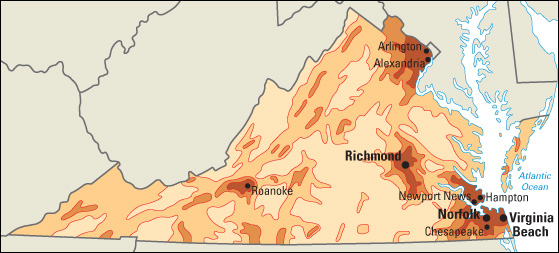
Nearly 90 percent of the people in Virginia live in the state’s 11 metropolitan areas (see Metropolitan area). These metropolitan areas are Blacksburg-Christiansburg-Radford; Charlottesville; Harrisonburg; Kingsport (Tennessee)-Bristol (Tennessee); Lynchburg; Richmond; Roanoke; Staunton-Stuarts Draft; Virginia Beach-Chesapeake-Norfolk; Washington, D.C.-Arlington-Alexandria; and Winchester. About 70 percent of Virginia’s people live in the Richmond; Virginia Beach-Chesapeake-Norfolk; and Washington, D.C.-Arlington-Alexandria metropolitan areas. Virginia Beach is the largest city in Virginia.
About 20 percent of Virginia’s people are African Americans. About 10 percent of the population is of Hispanic origin. Other large population groups in the state include people of English, German, and Irish descent. Many immigrants from Southeast Asia live in northern Virginia.
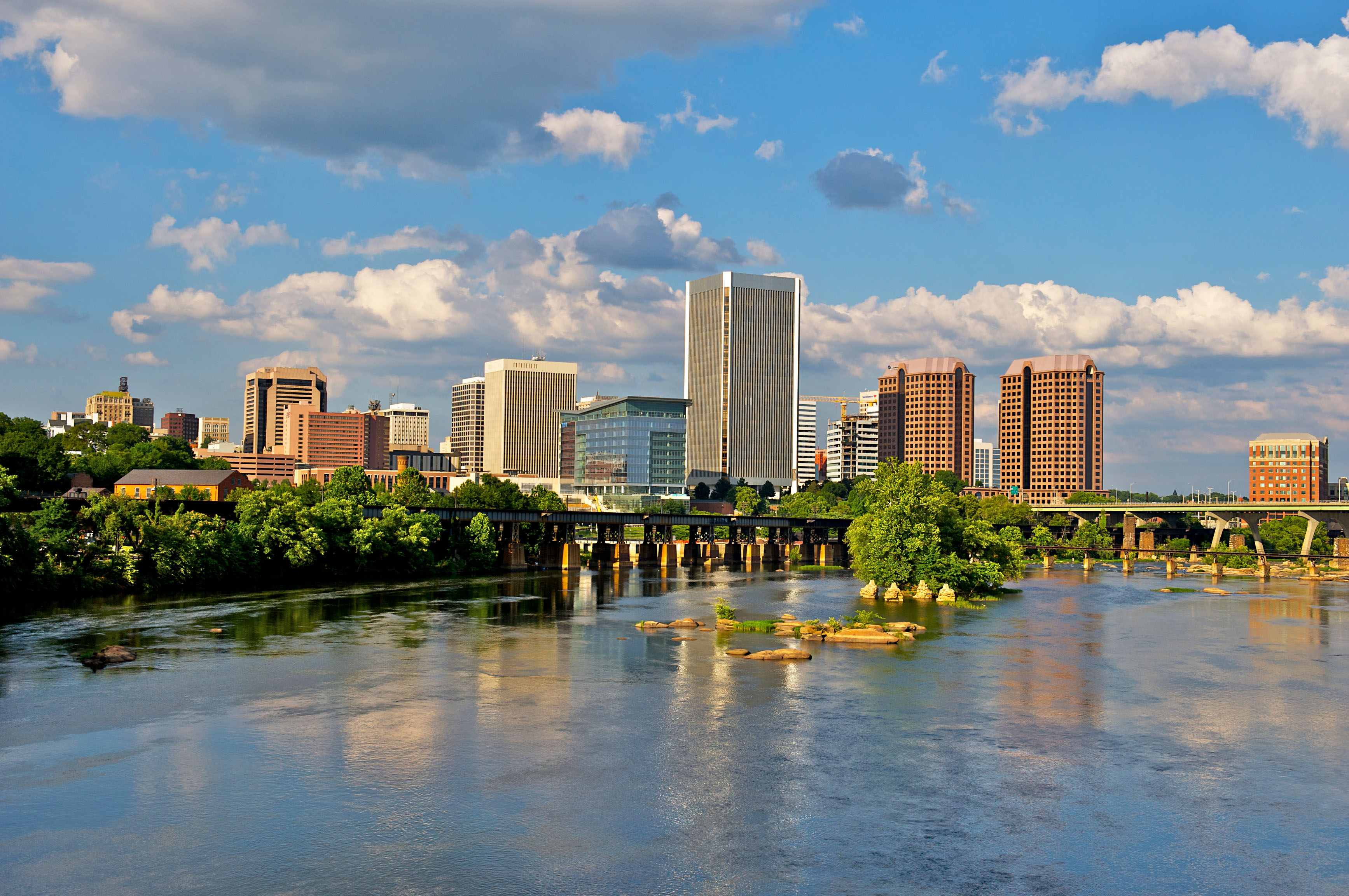
Schools.
The Syms Free School was founded in Hampton about 1635. It was the first free school in the United States. Another early free school, the Eaton Free School, was founded by about 1659, also in Hampton. Some Virginia communities established private schools called Old Field schools. They built these schools in open fields. Beginning in the mid-1700’s, many private academies were founded in Virginia. In 1810, the General Assembly created a literary fund in order to help poor children receive an education.
Virginia’s statewide public school system began in 1870. Today, the state Board of Education supervises Virginia’s public school system. The board’s nine members are appointed by the governor, subject to the approval of the legislature, to serve four-year terms. The board elects one of its members to serve as president.
The state Department of Education administers the public school system of Virginia, carrying out state laws and board of education regulations. The Department of Education is headed by the superintendent of public instruction. This official is appointed by the governor, subject to the approval of the legislature. The superintendent serves during the governor’s term of office.
A state law requires children from age 5 through 18 to attend school. For the number of students and teachers in Virginia, see Education (table).
The College of William and Mary, founded in Williamsburg in 1693, is the second oldest institution of higher learning in the United States. Harvard University is the oldest. Phi Beta Kappa, the honorary scholastic society, was founded at William and Mary in 1776 (see Phi Beta Kappa).
Libraries and museums.
Virginia’s first public library was established in Alexandria in 1794. Today public libraries serve Virginia’s cities, towns, and counties. The Library of Virginia in Richmond, founded in 1823, houses state and local government records and a special collection of works by Virginian authors.
The American Civil War Museum has exhibits that explain the perspectives of the Union, the Confederacy, and African Americans. It has three sites: Historic Tredegar, a former ironworks in Richmond; the White House of the Confederacy, also in Richmond, where Jefferson Davis lived as president of the Confederate States of America; and the American Civil War Museum — Appomattox, near the site on which Robert E. Lee surrendered to Ulysses S. Grant. The Virginia Historical Society in Richmond maintains the Virginia Museum of History & Culture. The museum’s exhibits and library, housed in a building known as Battle Abbey, explore themes from throughout Virginia’s history. 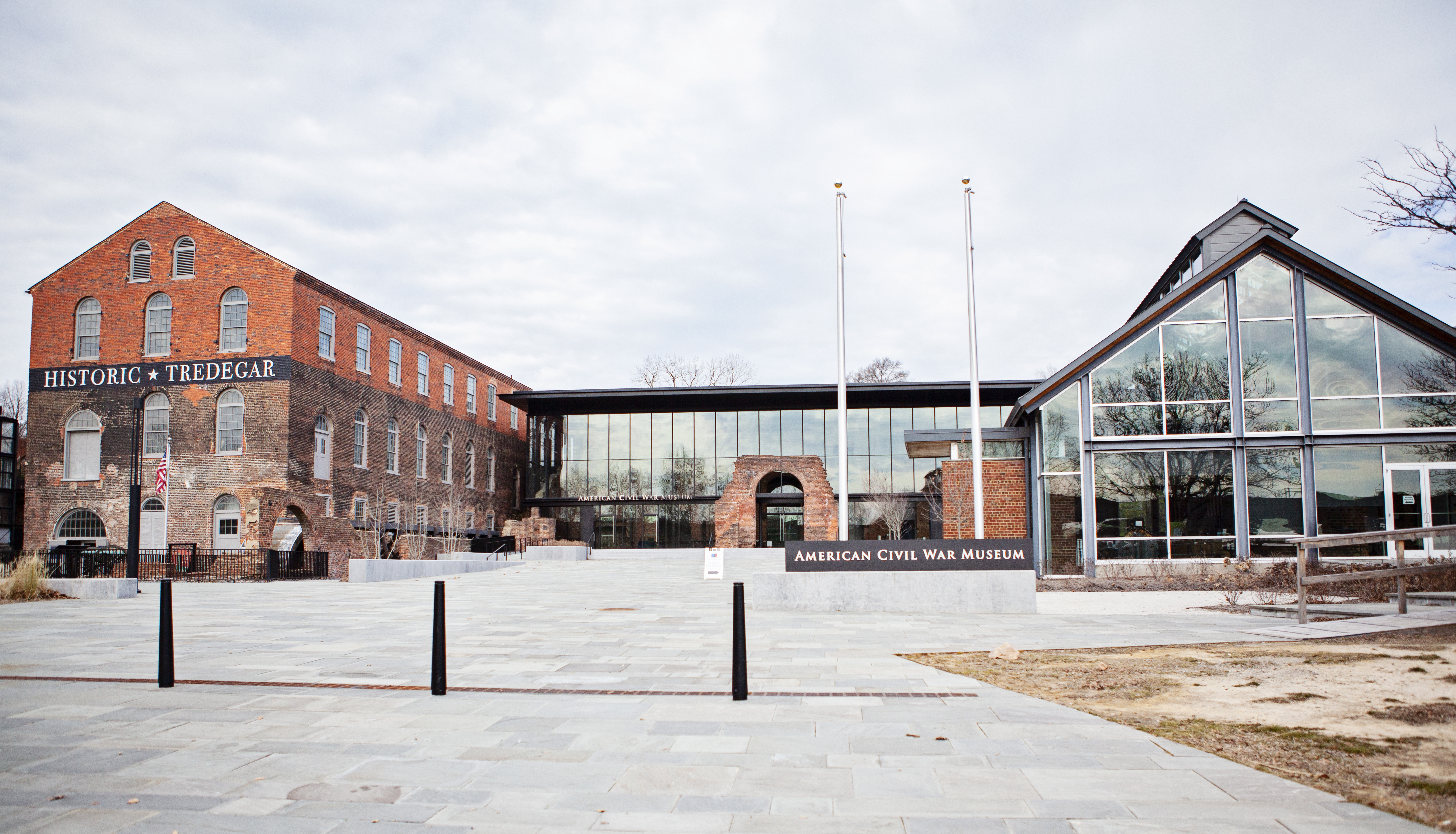
The Virginia Museum of Fine Arts in Richmond owns many valuable works of art. The Valentine museum in Richmond has exhibits on Richmond’s history. Also in Richmond, the Science Museum of Virginia has many interactive exhibits. The Edgar Allan Poe Museum in Richmond has exhibits dealing with the poet’s stay in that city. The Mariners’ Museum in Newport News displays models and paintings of ships, and other items that show the development of the shipping industry. The Virginia Museum of Natural History in Martinsville has exhibits and educational programs. The National Museum of the Marine Corps in Triangle, near the Marine Corps Base in Quantico, features galleries and exhibits that trace the history of the Marines from 1775 to the present. The Military Aviation Museum in Virginia Beach has a large collection of military aircraft from World War I and World War II. 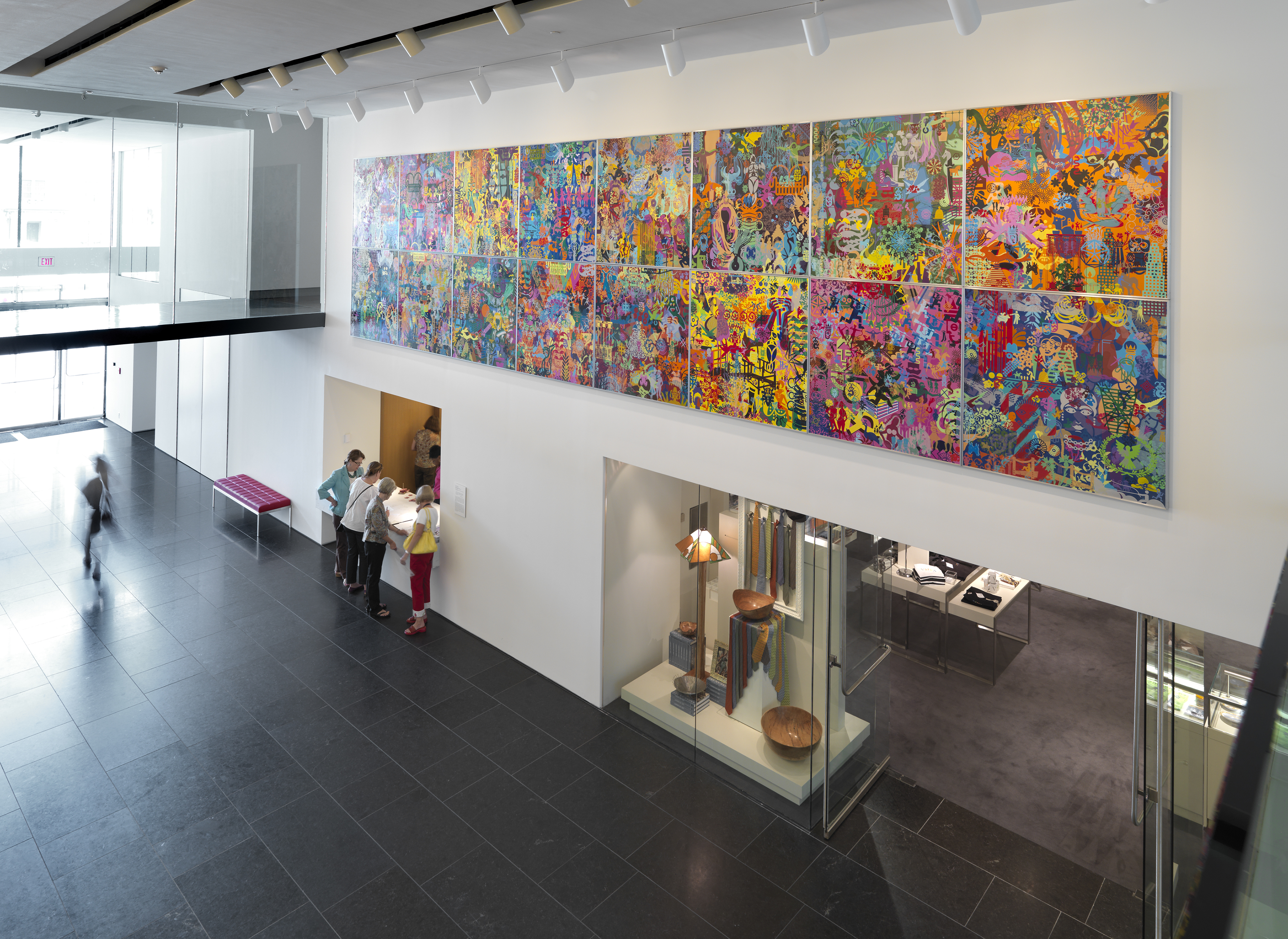
Visitor’s guide
Virginia is known for its stately old homes and other historic sites. The most popular homes include George Washington’s Mount Vernon near Alexandria, and Thomas Jefferson’s Monticello near Charlottesville. Williamsburg, Virginia’s second colonial capital, has been restored to look as it did in the 1700’s. See Monticello; Mount Vernon; Williamsburg.
Loading the player...Washington, the first President of the United States of America
Many visitors drive along the crest of the Blue Ridge Mountains. They travel on the Skyline Drive in the north, and on the Blue Ridge Parkway in the south. In spring, azaleas, dogwoods, and laurels bloom on the mountain slopes. In autumn, the leaves of hardwood trees and shrubs turn bright red, orange, and yellow.
The Atlantic Ocean, Chesapeake Bay, and tidal rivers offer boating activities, fishing, and beach sports. Virginia Beach is an especially popular ocean resort. Virginia’s mountains offer hiking, camping, and hunting. Virginia has many resort and public golf courses.
Many of Virginia’s most beautiful homes and gardens are open to the public during Historic Garden Week. This event takes place late in April. Another popular event is Pony Penning on Chincoteague Island, held on the last Wednesday and Thursday in July. The wild ponies live on nearby Assateague Island. But at Pony Penning time they are driven across the shallow channel to Chincoteague, where some of them are auctioned off.
Land and climate
Land regions.
Virginia has five main land regions: (1) the Appalachian Plateau, (2) the Ridge and Valley Region, (3) the Blue Ridge, (4) the Piedmont Plateau, and (5) the Atlantic Coastal Plain.
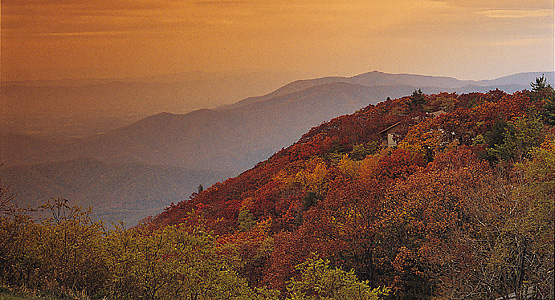

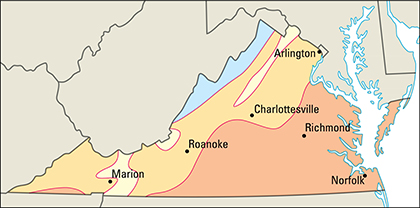
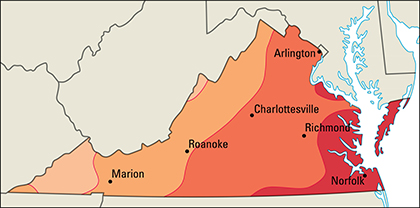
The Appalachian Plateau
is a rugged region in the southwestern part of the state. It has an average elevation of 2,000 feet (610 meters). Many streams flow west through the region. In some places, they have cut deep gorges. The plateau is covered with forests and has valuable coal fields.
The Ridge and Valley Region
consists of a series of parallel mountain ridges that extend northeast and southwest along most of the state’s western border. The Great Valley, or Valley of Virginia, lies in the eastern part of this region. The Great Valley is a series of separate river valleys. The largest is the Shenandoah Valley in the north. A prominent mountain ridge, the Massanutten, divides the Shenandoah Valley into two parts for much of its length. The Ridge and Valley Region has many caves and other formations created by the action of water on limestone.
The Blue Ridge
borders the Ridge and Valley Region on the east. It is the main eastern range of the Appalachian Mountain System and an outstanding feature of Virginia. Northeast of Roanoke, the ridge is narrow and rises sharply from the lower land east and west of it. South of Roanoke, the Blue Ridge broadens into a plateau with mountain peaks, valleys, and deep ravines. The highest peaks in Virginia—Mount Rogers (5,729 feet, or 1,746 meters) and Whitetop Mountain (5,520 feet, or 1,682 meters)—are in the southern part of the Blue Ridge.
The Piedmont Plateau,
in central Virginia, is the state’s largest land region. It is an elevated, gently rolling plain, about 40 miles (64 kilometers) wide in the northeast and widening to about 140 miles (225 kilometers) at the North Carolina border. The Piedmont Plateau has an average elevation of 800 to 900 feet (240 to 270 meters) in the west. It slopes gradually to an average elevation of 200 to 300 feet (61 to 91 meters) in the east. Many rivers and streams flow southeast across the Piedmont Plateau. They break into low waterfalls at the eastern edge of the region, known as the fall line (see Fall line).
The Atlantic Coastal Plain
is a lowland region about 100 miles (160 kilometers) wide that extends north and south along the Atlantic Ocean. It is often called the Tidewater, because tidal water flows up its bays, inlets, and rivers. Chesapeake Bay divides the region into a western mainland section and a peninsula called the Eastern Shore. The region has salt marshes and swamps. The largest is the Great Dismal Swamp, in the southeastern part of the state.
Coastline.
Virginia has a general coastline of 112 miles (180 kilometers). The tidal shoreline (including small bays and inlets) is 3,315 miles (5,335 kilometers). Sand bars and islands along the coast have created several lagoons. A long, sandy beach stretches south from the Norfolk area. Ocean waves have eroded (worn away) much of the shoreline.
Rivers and lakes.
Several rivers flow from the western mountains and the Piedmont Plateau into Chesapeake Bay. These rivers include the Rappahannock, James, and York. They divide the Tidewater area into a series of peninsulas. The Potomac River forms Virginia’s northeastern border. It is an important transportation route between Alexandria and Chesapeake Bay. The Shenandoah River flows north through the Great Valley and empties into the Potomac.
The Roanoke River flows southeast across the Piedmont Plateau into North Carolina. The New River begins in North Carolina and flows north and west through southwestern Virginia into West Virginia. Several rivers in the southwestern corner of the state, including the Clinch, Holston, and Powell, flow southwest toward the Tennessee Valley.
Virginia has two natural lakes—Lake Drummond (3,200 acres, or 1,290 hectares), which lies in the Great Dismal Swamp, and small Mountain Lake, which lies near the top of Salt Pond Mountain in southwestern Virginia. Many artificial lakes have been formed by damming rivers for hydroelectric power, recreation, or other purposes. The largest of these is Kerr Reservoir on the Virginia–North Carolina border. About 36,140 acres (14,625 hectares) of this lake are in Virginia.
Plant and animal life.
Forests cover more than 60 percent of Virginia. Common trees include ashes, beeches, birches, black tupelos, hemlocks, hickories, locusts, maples, red cedars, sweet gums, and yellow-poplars. Red spruces can be found on the highest peaks. Flowering dogwood, the state flower, blooms in early spring. Wild azaleas, mountain laurels, redbuds, rhododendrons, and other flowering plants grow in mountain areas. Wildflowers include bloodroots, mayapples, violets, and Virginia bluebells.
Deer roam the wooded areas. Black bears and wild cats live in the mountains and in the Great Dismal Swamp. Small animals include foxes, muskrats, opossums, rabbits, and raccoons. Ducks, geese, quails, ruffed grouse, and turkeys live in the state. Freshwater fishes include alewife, bass, carp, perch, pickerel, pike, and trout. Drum, flounder, mackerel, menhaden, and shad swim in the Atlantic Ocean, in Chesapeake Bay, and in Virginia’s many inlets. Clams, crabs, oysters, and scallops live in Chesapeake Bay and in shallow coastal waters.
Climate.
The climate of Virginia is mild. Temperatures vary from east to west as the elevation of the land and the distance from the ocean increase. In January, temperatures average 40 °F (4 °C) in the Tidewater area, and about 34 °F (1 °C) in parts of the Blue Ridge. July temperatures average 80 °F (27 °C) in the Tidewater and about 70 °F (21 °C) in the mountains. 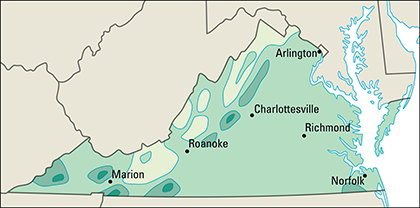
The state’s highest temperature, 110 °F (43 °C), occurred at Columbia on July 5 and 7, 1900, and at Balcony Falls, near Glasgow, on July 15, 1954. The record low, –30 °F (–34 °C), occurred at Mountain Lake Biological Station on Jan. 21, 1985.
Virginia’s precipitation (rain, melted snow, and other forms of moisture) is lightest in the north, where it averages about 39 inches (99 centimeters) a year. In the south, it averages about 46 inches (117 centimeters). Snowfall ranges from 5 to 10 inches (13 to 25 centimeters) in the Tidewater to 25 to 30 inches (64 to 76 centimeters) in the western mountains.
Economy
Throughout its early history, Virginia had an agricultural economy based on tobacco and other plantation crops. Government activities and manufacturing industries grew rapidly after about 1940. Today, service industries, taken together, account for the largest portion of Virginia’s gross domestic product—the total value of all goods and services produced in the state in a year. Many federal government agencies operate in northern Virginia, near Washington, D.C. Virginia also benefits from military bases in the state.
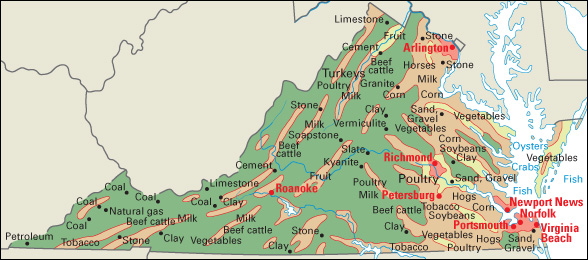
Virginia’s location near the highly populated Northeast and the rapidly growing Southeast is favorable for manufacturing and trade. Plentiful natural resources, good transportation by land and water, and a growing population also favor these industries. Virginia’s historic sites, beaches, and other attractions draw tens of millions of tourists each year.
Natural resources
of Virginia include varied soils and many mineral deposits.
Soil.
Most of the western, mountainous part of Virginia has shallow, rocky soils. The valley soils are stony and not fertile, except in parts of the Shenandoah Valley and other areas where the soil contains much lime. Soils are stony and shallow in the northern part of the Blue Ridge but deeper and darker in the southwest. Piedmont soils are generally light in color and have a loamy texture. Most soils in the Atlantic Coastal Plain are sandier than those in other parts of Virginia. The sandy soils are generally deep and easily cultivated.
Minerals.
Coal is one of Virginia’s most important mined resources. Most of the coal comes from the southwestern part of the state. Bituminous (soft) coal makes up most of the state’s reserves. The famous Pocahontas coal of Buchanan and Tazewell counties is among the bituminous deposits.
Virginia stones include basalt, dolostone, gneiss, granite, limestone, marble, sandstone, shale, slate, soapstone, and traprock. Most of the limestone is found in the Ridge and Valley Region. The Atlantic Coastal Plain has large deposits of clay and sand and gravel. Some manganese and iron ore occur in mountainous areas. Other mined products include kyanite, used in ceramics; natural gas; petroleum; and vermiculite, used in building materials.
Service industries
account for the majority of both Virginia’s employment and its gross domestic product. Service industries are concentrated in the Richmond and Virginia Beach-Norfolk areas and in the area near Washington, D.C.
Federal government agencies have many offices in northeastern Virginia. The Pentagon is in Arlington, and the headquarters of the Central Intelligence Agency is in McLean. Military bases include Naval Station Norfolk and Marine Corps Base Quantico. Computer programmers, consultants, engineers, and researchers receive much business from federal government agencies. Most state government offices are in Richmond.
Richmond and the area near Washington, D.C., are the state’s leading banking centers. Richmond is the headquarters of the Fifth Federal Reserve District Bank, one of the 12 federal banks established by Congress.
Tourists visiting Virginia’s coastal, mountain, and urban areas provide much income for the state’s hotels, resorts, and restaurants. Several companies have telemarketing or mail-order operations based in Virginia. Norfolk Southern, one of the nation’s largest railroad companies, is headquartered in Virginia.
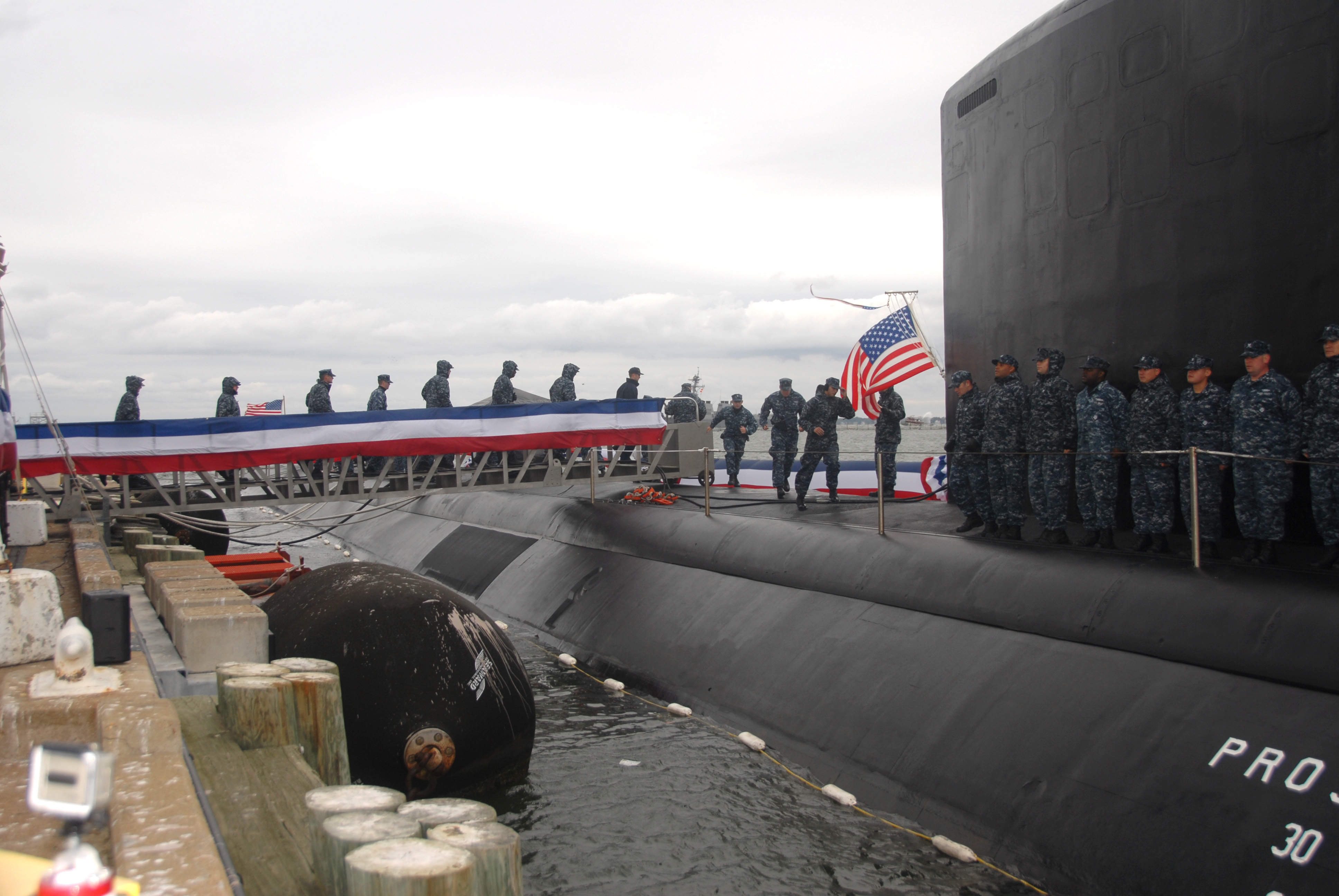
Manufacturing.
Beverage and tobacco products are Virginia’s leading type of manufactured products. Tobacco products are the most valuable part of this sector by far. Most of the state’s tobacco industry income comes from cigarette factories in Richmond. Soft drinks and beer are made in several parts of the state.
Chemicals, food products, and transportation equipment are also leading manufactured products. Pharmaceuticals (medicinal drugs) are the leading chemical product. Elkton, Petersburg, and Richmond have pharmaceutical plants. Virginia’s chief food products include baked goods, dairy products, and meat products. Smithfield is famous for hams. The Shenandoah Valley has large poultry-processing plants. Boats and ships, motor vehicle parts, and trucks are made in Virginia. Newport News has large shipbuilding yards. Northrop Grumman Corporation and General Dynamics Corporation, both large aircraft manufacturers, have their corporate headquarters in Falls Church. Norfolk and Portsmouth also have shipbuilding and repair yards.
Virginia’s other manufactured products include computer and electronic products, fabricated metal products, and plastics and rubber products. Scientific instruments and semiconductors are Virginia’s leading types of computer and electronic equipment. Fabricated metal products are primarily manufactured near Lynchburg. Tires are manufactured in the Danville and Roanoke areas.
Agriculture.
Virginia’s farmland covers about a third of the state’s land area. Livestock and livestock products provide about two-thirds of Virginia’s farm income. Broilers (young, tender chickens) are the state’s most valuable farm product. Beef cattle, dairy products, and turkeys rank next among Virginia’s livestock products. Rockingham County in northwestern Virginia is a leading producer of beef cattle, broilers, milk, and turkeys. Virginia ranks as an important state in raising turkeys. Farmers also raise hogs, mainly in southeastern Virginia. 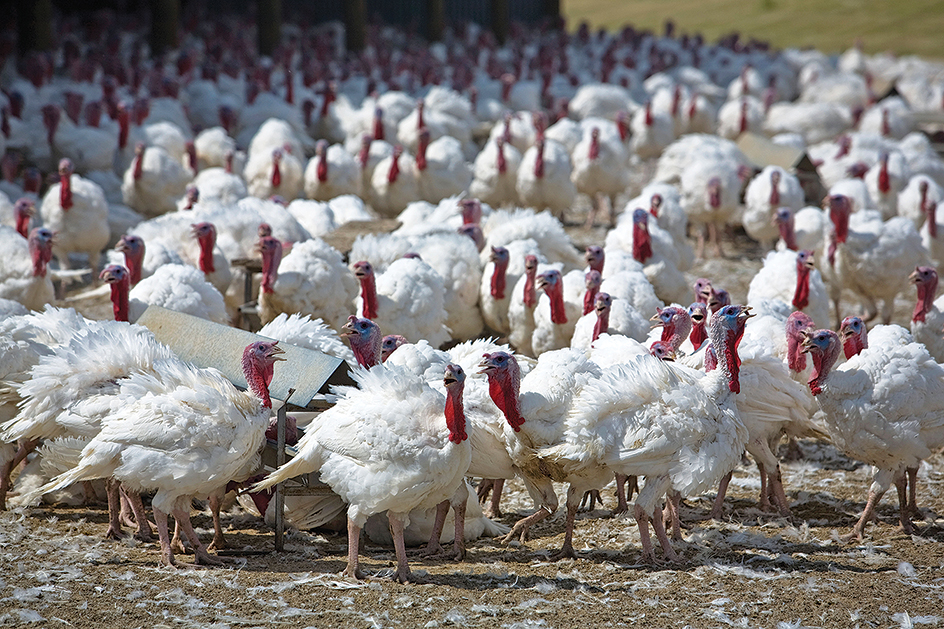
Tobacco, once the basis of Virginia’s economy, remains one of the state’s most valuable cash crops. Farmers grow tobacco on only a small part of Virginia’s cropland. Most tobacco is grown in the southern part of the state. Farmers grow corn and soybeans in southeastern Virginia. 
Greenhouse and nursery products are important farm products. Virginia’s leading vegetable crops include potatoes and tomatoes. Much of the vegetable production takes place on the Eastern Shore. Orchards in the Shenandoah Valley grow apples.
Mining.
Coal is one of Virginia’s chief mined products. Most of it comes from Buchanan, Dickenson, and Wise counties in the southwestern part of the state. Most mines are underground and produce bituminous coal.
Crushed stone and natural gas are also valuable. Granite is the leading crushed stone product. Natural gas comes mainly from wells in western Virginia. The state’s other mined products include cement, clay, lime, and sand and gravel. Virginia is the only state to mine kyanite, a mineral used for insulation.
Fishing industry.
Virginia is a leading state in menhaden and scallop production. Other important fishing catches include Atlantic croaker, blue crabs, summer flounder, oysters, spot, and striped bass. The Hampton Roads area has the state’s leading fishing port.
Electric power and utilities.
Dominion Virginia Power is the state’s biggest utility. Nuclear power plants and plants that burn natural gas account for the majority of Virginia’s electric power. Hydroelectric plants, solar power plants, and plants that burn coal provide most of the rest of the state’s power.
Transportation.
Virginia has an extensive system of roads and highways. Long bridges cross the Tidewater rivers. The Chesapeake Bay Bridge Tunnel, 18 miles (29 kilometers) long, connects the mainland with the Eastern Shore. Ferries operate across some bay inlets.
The first Virginia railroad began operating in 1831. The wooden track, 13 miles (21 kilometers) long, linked the coal mines of Chesterfield County with Richmond. Today, rail lines provide freight service on thousands of miles of rail track in the state.
Virginia is home to two of the nation’s busiest airports. Washington Dulles International Airport, one of the nation’s largest in area, is in Herndon. Ronald Reagan Washington National Airport is near Alexandria. Virginia’s other main airports are at Norfolk and Richmond.
Large ships can travel on Chesapeake Bay and some distance up the James and Potomac rivers. Hampton Roads, at the junction of the James, Nansemond, and Elizabeth rivers, is an important harbor area. Norfolk, on Hampton Roads, is one of the leading U.S. ports. Other ports include Newport News on Hampton Roads, Alexandria on the Potomac, and Hopewell and Richmond on the James. The Dismal Swamp Canal and the Albemarle and Chesapeake Canal form part of the Atlantic Intracoastal Waterway, a sheltered water route used by boats along the Atlantic Coast.
Communication.
In 1736, William Parks, Virginia’s public printer, founded the Virginia Gazette, the first newspaper in the colony. Today, the Richmond Times-Dispatch and The Virginian-Pilot of Norfolk are among the most widely read dailies in the state. USA Today, a national newspaper, is based in Virginia.
Government
Constitution
of Virginia became effective in 1971. The state had five earlier constitutions, which went into effect in 1776, 1830, 1851, 1869, and 1902. 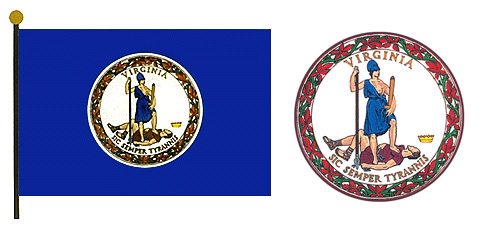
Constitutional amendments may be proposed in either house of the state legislature. To become law, the proposed amendments must be approved by a majority of both houses in two successive sessions. Then they must be approved by a majority of people who vote on the issue. The Constitution may also be amended by a constitutional convention. Such a convention is called by a two-thirds vote of members elected to each house of the legislature.
Executive.
The governor of Virginia is elected to a four-year term and cannot serve two terms in a row. The lieutenant governor also is elected to a four-year term. The governor appoints almost all the top state officials, including the secretary of the commonwealth, adjutant general, treasurer, and comptroller. The people of Virginia elect the attorney general to a four-year term. The legislature elects the auditor, who also serves a four-year term.
Legislature
of Virginia is called the General Assembly. It is the oldest representative legislature in America. It traces its history to the House of Burgesses, formed in 1619 (see House of Burgesses). 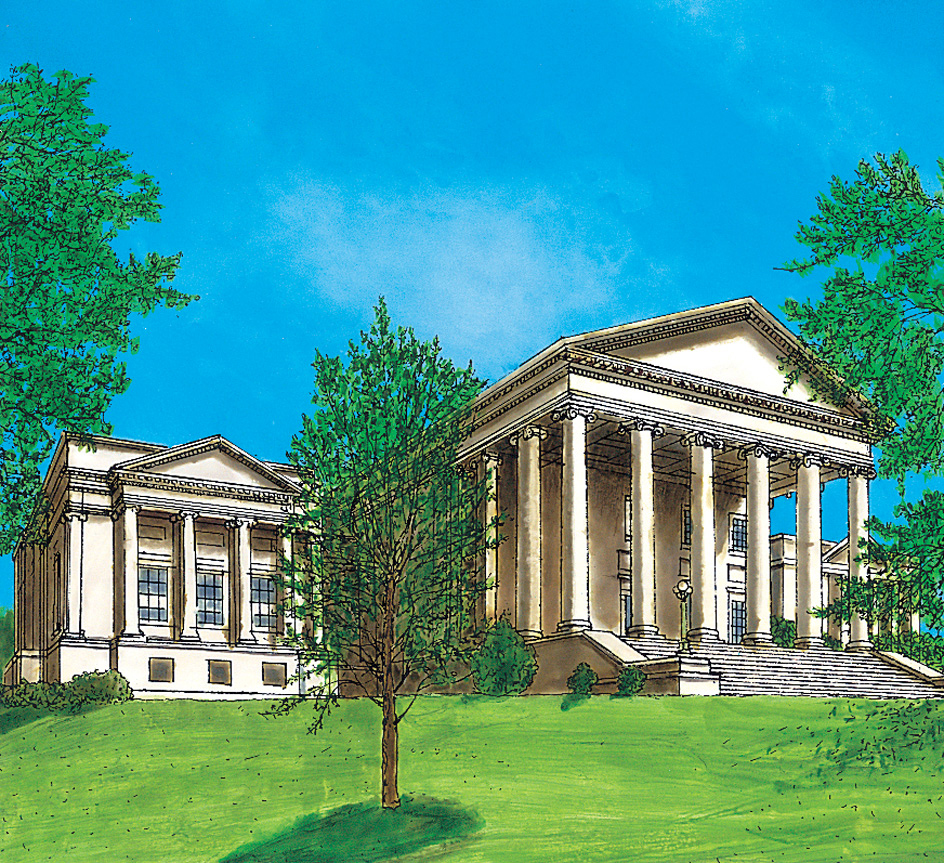
The General Assembly consists of a 40-member Senate and a 100-member House of Delegates. The Senate and the House of Delegates are apportioned into single-member districts. Voters in each senatorial district elect one senator, and voters in each delegate district elect one delegate. Senators serve four-year terms, and delegates serve two-year terms.
The General Assembly holds regular sessions every year. Sessions begin on the second Wednesday in January. They last up to 60 days in even-numbered years and up to 30 days in odd-numbered years. The General Assembly may extend a session by up to 30 days. The governor may call special sessions.
Courts.
The state’s highest court is the Supreme Court of Virginia. It has seven justices, who are elected by the General Assembly to 12-year terms. The chief justice is chosen by a majority vote of the seven justices. The next highest court is the Court of Appeals of Virginia. It hears criminal cases, workers’ compensation cases, domestic relations cases, and appeals from the Circuit Court, the next highest court in Virginia. Judges on the Court of Appeals and the Circuit Court serve eight-year terms. Lower courts in Virginia include juvenile and domestic relations courts and general district courts. The General Assembly elects the judges of these courts to six-year terms.
Local government.
Virginia has 95 counties. Each county, except Arlington, is governed by a board of supervisors. Arlington has a county board. In most counties, voters elect other officials, including a commissioner of revenue, treasurer, sheriff, commonwealth’s attorney, and circuit court clerk. The circuit court clerk has an eight-year term. The other county officials are elected to four-year terms. A few counties have a county-manager or county-executive government. In these Virginia counties, a county manager or the board of supervisors appoints executive officials.
Any Virginia town with 5,000 or more people may become an independent city if the people so wish. Virginia has about 40 independent cities. Unlike the cities of most other states, these cities are legally separate from the counties in which they lie. One of the first forms of council-manager government in a U.S. city was established in Staunton in 1908. Today, all Virginia cities have council-manager governments. Some towns in Virginia have council-manager governments, and the others have mayor-council governments.
Revenue.
Taxes account for approximately half of the state government’s general revenue (income). Most of the rest comes from federal grants and charges for state government services. A state lottery also contributes to the general revenue. The largest source of state tax revenue in Virginia is a personal income tax. The second largest source of tax revenue is a general sales tax. Other important tax revenue sources include taxes on alcoholic beverages, corporate income, inheritance taxes, motor fuels, motor vehicle licenses, public utilities, and tobacco products.
Politics.
The Democratic Party controlled Virginia politics throughout most of the state’s history. However, Republican Party strength increased during the last half of the 1900’s. In 1969, A. Linwood Holton, Jr., became the first Republican to be elected governor of Virginia since 1869. By the end of the 1990’s, the Republican Party had become the dominant party in the state. By the early 2000’s, however, the population of northern Virginia, near Washington, D.C., had grown significantly. The area’s moderate and liberal voters helped carry the Democrats to victory in campaigns for governor and U.S. Senate.
Until the 1950’s, Virginia voted for the Democratic candidate in presidential elections most of the time. In the late 1900’s, the state’s voters usually supported the Republican candidate. Democratic presidential candidates had success in Virginia in the 2000’s.
History
Early days.
When the first English colonists arrived in the Virginia region, Indigenous (native) tribes of three major language groups lived there. The Powhatan, who were members of the Algonquian language group, lived in the coastal area. The Monacan and Manahoac, who spoke the Siouan language, occupied the Piedmont Plateau. Other Siouan tribes included the Nahyssan along the James River, and the Occaneechi on the Roanoke River. The Susquehanna near the upper Chesapeake Bay, the Cherokee in the southwest, and the Nottoway in the southeast spoke the Iroquoian language.
The first Europeans who settled in Virginia were a group of Spanish Jesuits. In 1570, the group established a mission, perhaps on the York River. However, Indigenous warriors wiped out the settlement a few months later.
In 1584, Queen Elizabeth I of England gave the English adventurer Sir Walter Raleigh permission to establish colonies in America. Raleigh and others soon sent expeditions there. These expeditions failed because they did not have enough supplies. Historians think it was Raleigh who gave the name Virginia to what is now the Eastern United States. The name honored Elizabeth, who was known as the Virgin Queen.
The Jamestown settlement.
In 1606, King James I chartered the Virginia Company of London (later shortened to Virginia Company) for colonization purposes (see London Company). In May 1607, colonists sent by the company established the first permanent English settlement in America, at Jamestown. The colony, led by Captain John Smith, survived many hardships. In 1609, Smith was injured and had to return to England. The following winter, so many settlers died from lack of food that the period became known as the starving time. In the spring, the discouraged colonists started to leave Jamestown. But they returned after they met the ships of Governor Thomas West, Lord De La Warr, at Hampton Roads. The ships brought supplies and new colonists. After Lord De La Warr returned to England, Thomas Gates and Thomas Dale served as deputy governors. 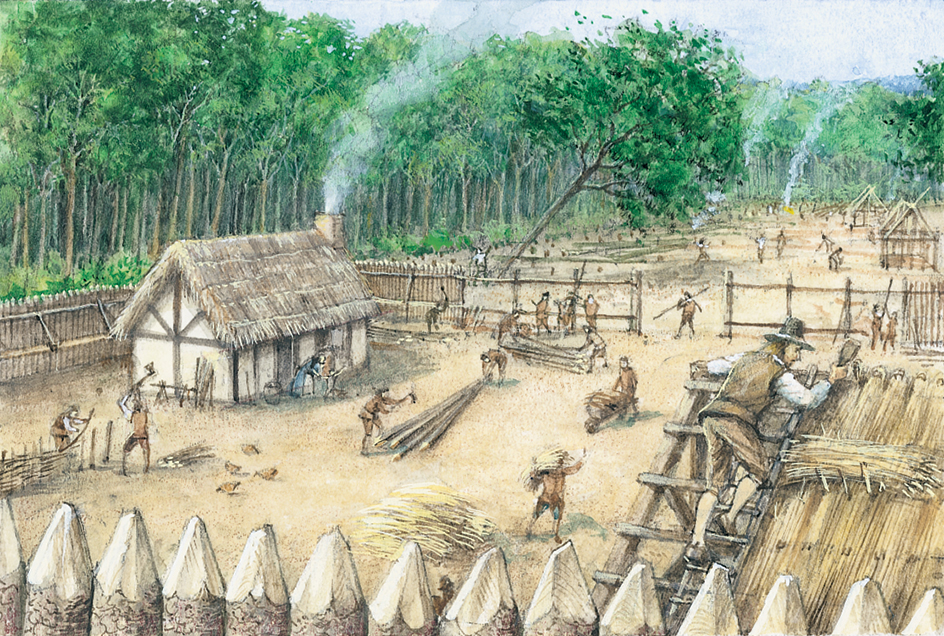
Progress of the colony.
John Rolfe, one of the colonists, began to raise tobacco in 1612. Rolfe introduced a kind of tobacco from the Caribbean and improved on local methods of curing tobacco. Rolfe also proved that tobacco could be successfully exported. Tobacco exporting helped save the colony by giving the people a way to support themselves. In 1614, Rolfe married Pocahontas, a daughter of Powhatan, chief of the Indigenous confederation around Jamestown. Their marriage brought a period of peace between Indigenous people and the colonists.
By 1619, all free colonists had been granted land of their own. That year, the Virginia Company made plans to send young women to the colony to become wives of the lonely settlers.
Also in 1619, the first Black Africans were brought to Jamestown. These people had been captured in Africa and placed on a Portuguese ship. English warships working as privateers for the Dutch captured the Portuguese ship. Privateers were privately owned vessels hired by a government to attack enemy ships. The African captives were transferred to the English ships and sold at auction in Jamestown.
The first representative legislature in America, the House of Burgesses, was formed in 1619. Its first meeting was called by Governor George Yeardley, who acted on instructions from the Virginia Company. The House of Burgesses met with the governor and his council to make laws for the colony. This combined lawmaking body was called the General Assembly of Virginia.
Powhatan, the friendly chief, died in 1618. In 1622, his successor, Chief Opechancanough, led an attack on the colonists. Opechancanough’s warriors killed more than 300 colonists.
Royal governors and Cromwell.
In 1624, King James I revoked the Virginia Company’s charter and made Virginia a royal colony. The colonists often quarreled with the royal governors sent by England. Sir William Berkeley, who served as governor from 1642 to 1652, had good relations with the colonists. But in 1652, Berkeley was forced to surrender Virginia to the rule of Oliver Cromwell, who had overthrown King Charles I.
From 1652 until Charles II became king in 1660, the Virginia colonists were allowed to take almost complete charge of their own government. In spite of the political freedom they enjoyed under Cromwell, most of the colonists remained loyal to the English royalists. Some English supporters of the future King Charles II, called Cavaliers, sought refuge in Virginia.
In 1660, after Berkeley had been elected by the royalist Virginia assembly, Charles II reappointed him governor. Berkeley’s new term brought widespread discontent. The governor kept the same members of the House of Burgesses in office for 14 years. Berkeley also allowed a Tidewater aristocracy to rule the colony. This group included the heads of the wealthy eastern families.
Westward expansion.
By the mid-1600’s, many small farmers had pushed westward to the eastern edge of the Piedmont Plateau. This area is known as the fall line. The interests of the western farmers differed from those of the Tidewater aristocracy. The westerners wanted protection from Indigenous groups and fewer political and economic regulations. They resented the English government’s navigation acts, which greatly restricted colonial trade (see Navigation Acts). A group of discontented colonists rebelled against the government in 1676. They were led by Nathaniel Bacon, a young planter (see Bacon’s Rebellion). In 1699, the capital was moved from Jamestown to Williamsburg. 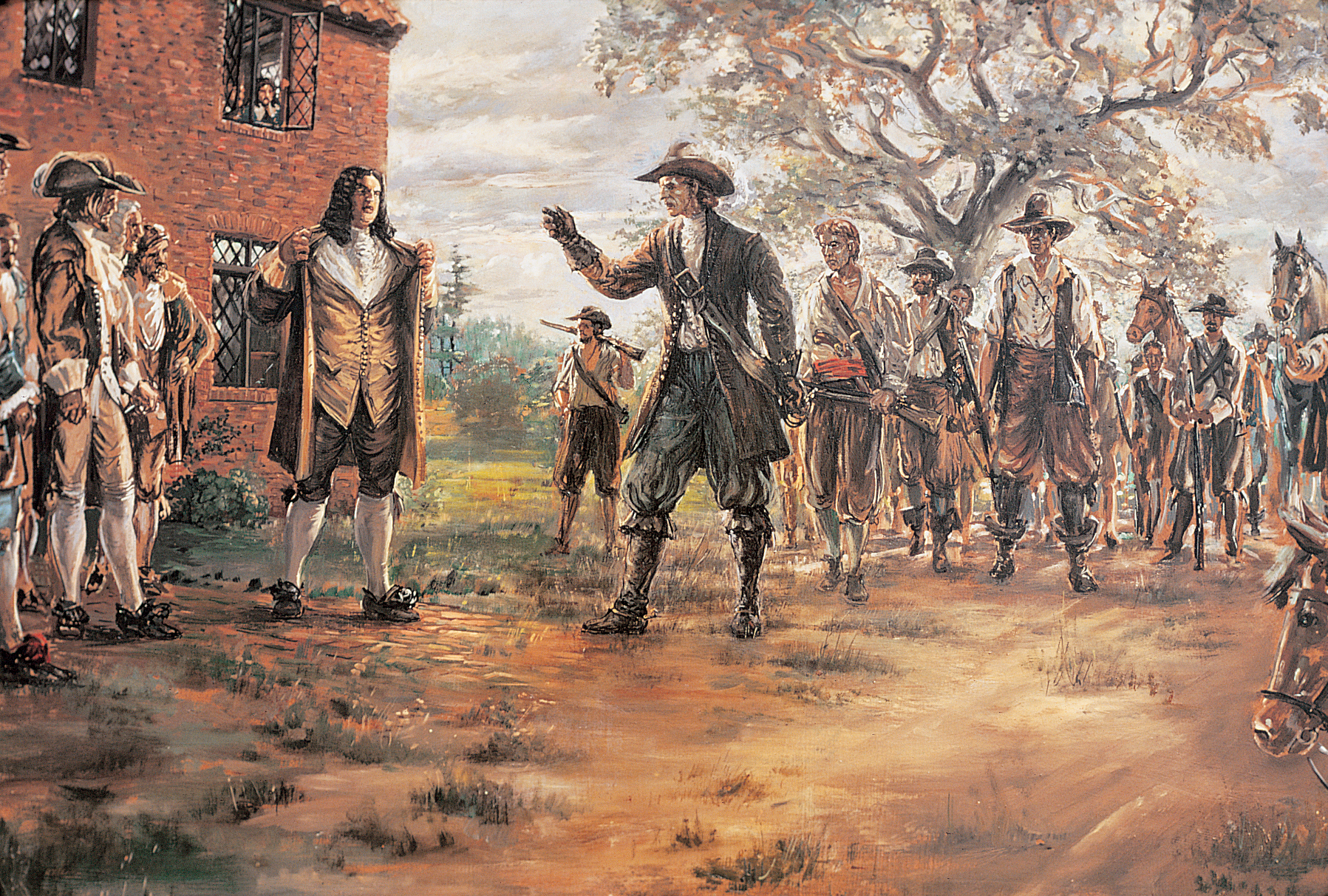
By 1700, Virginia had a population of about 58,000 and was the largest North American colony. The growing population took up all the land along the tidal rivers and creeks. Therefore, many pioneers moved westward into the Piedmont Plateau, the Great Valley, and the mountains. Germans and Scotch-Irish from Pennsylvania also settled in the Great Valley. The westward expansion of the British colonists conflicted with the interests of the French and led to the French and Indian War of 1754-1763 (see French and Indian wars).
During the early 1770’s, frequent raids by Indigenous groups spread terror along the western frontier. In 1774, these attacks led to a campaign against Indigenous people called Lord Dunmore’s War, after Virginia’s governor, John Murray, Earl of Dunmore. A group of Virginia soldiers led by Andrew Lewis defeated the Shawnee at Point Pleasant (now in West Virginia) on Oct. 10, 1774. The attacks then decreased in western Virginia.
The course toward independence.
Like many other colonists, Virginia’s leaders were disturbed by the laws passed by the British Parliament without the consent of the colonies, see American Revolution (British policy changes). Although most Virginians were loyal to the king, they favored liberty and wanted to govern their own affairs. Virginia’s leaders, including Patrick Henry and Thomas Jefferson, led the way in voicing the complaints of the colonists. Patrick Henry’s resolutions helped arouse the colonists against the Stamp Act in 1765 (see Stamp Act).
In 1774, the British Parliament ordered the port of Boston closed, following the Boston Tea Party in 1773 (see Boston Tea Party). The House of Burgesses, in sympathy with the Boston colonists, made the day of the port closing a day of fasting and prayer. This action angered Lord Dunmore, and he dissolved the House of Burgesses. Its members then met without official permission on Aug. 1, 1774, in Williamsburg. They called themselves the First Virginia Convention. The members elected delegates to the First Continental Congress (see Continental Congress). A Virginia delegate, Peyton Randolph, was chosen president of the congress.
At the Second Virginia Convention, on March 23, 1775, at St. John’s Church in Richmond, Patrick Henry made his plea for the colonial cause. According to tradition, his speech included the famous words, “Give me liberty or give me death!”
Independence and statehood.
In 1775, the Second Continental Congress elected George Washington, a Virginian, as commander in chief of the Continental Army. Virginia became an independent commonwealth in June 1776, when it adopted its first constitution. The constitution included a declaration of rights written by Virginia statesman George Mason. This declaration was the first bill of rights in an American constitution. Patrick Henry was elected as the commonwealth’s first governor. The capital of the commonwealth was moved from Williamsburg to Richmond in 1780. 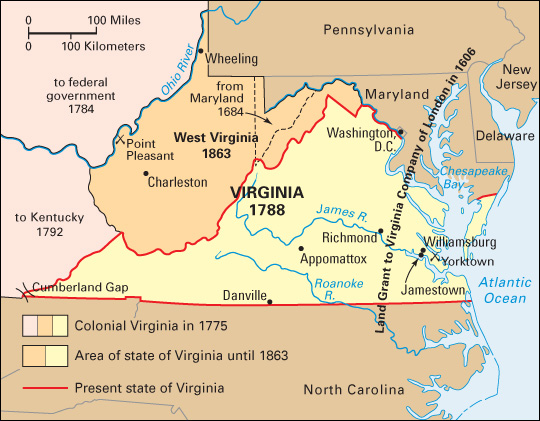
Virginia militiamen drove Lord Dunmore from the colony after several skirmishes in 1776. Also in 1776, the colony submitted to the Continental Congress a resolution calling for American independence (see Declaration of Independence).
During the Revolutionary War (1775-1783), a larger proportion of people in Virginia opposed the British than in any other southern colony. The Declaration of Independence was written by Thomas Jefferson, who later served as the state’s second governor. Virginia also contributed the great cavalry leader “Light-Horse Harry” Lee and Daniel Morgan, the hero of the battles of Freeman’s Farm and Cowpens. In 1778 and 1779, George Rogers Clark won victories in the Northwest Territory. His forces took from the British Kaskaskia and Cahokia in what is now Illinois, and Vincennes in present-day Indiana. This territory had long been claimed by Virginia. In 1781, the last major battle of the war was fought on Virginia soil, at Yorktown. In the battle, Lord Cornwallis surrendered to George Washington. 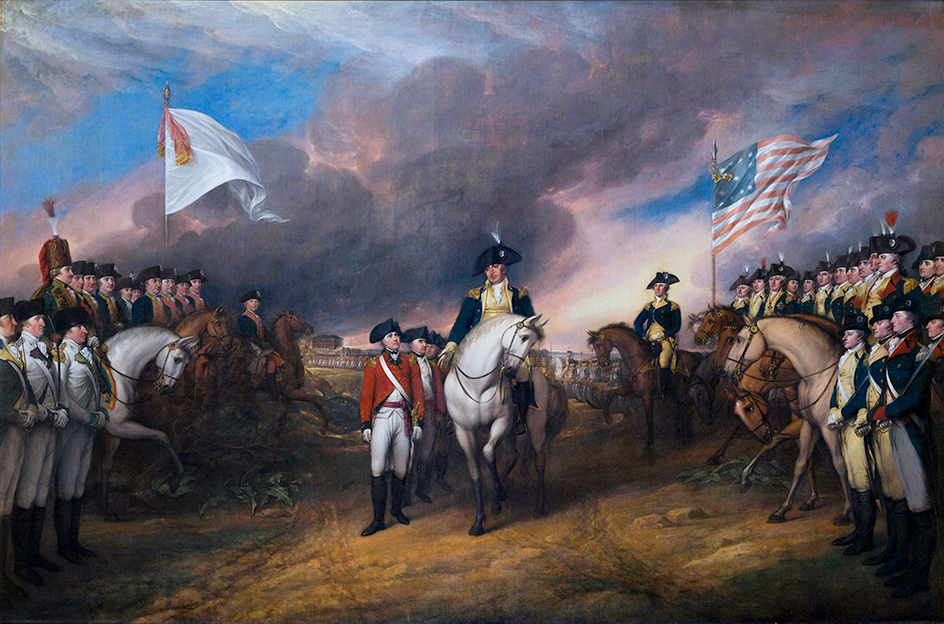
Until 1789, the 13 former colonies were loosely joined under the Articles of Confederation (see Articles of Confederation). Virginia had ratified (approved) the Articles on July 9, 1778. In order to persuade Maryland to accept the Articles, Virginia promised in 1781 to give up its claim to the Northwest Territory. Virginia did so in 1784 (see Northwest Territory).
The Articles of Confederation soon proved ineffective. James Madison and other Virginians led in creating the Constitution of the United States to replace the Articles. Virginia ratified the Constitution on June 25, 1788, and became the 10th state of the Union. See Constitution of the United States.
The Mother of Presidents.
Virginia furnished the United States with four of its first five presidents—George Washington, Thomas Jefferson, James Madison, and James Monroe. Washington was elected as the first president in 1789. He appointed Jefferson as the first secretary of state and Edmund Randolph as the first attorney general. In 1792, the westernmost counties of Virginia became the state of Kentucky.
Thomas Jefferson, James Madison, and James Monroe were often called the Virginia Dynasty. During their presidential terms, they strengthened the new nation and added new territory to it. Another Virginian, John Marshall, served as chief justice of the United States from 1801 to 1835.
In 1830, Virginia adopted a new constitution, chiefly as a result of growing discontent in the western counties. The new constitution gave the westerners more representation in the General Assembly. But eastern leaders kept control of the government.
In 1831, Nat Turner, an enslaved Black preacher from Southampton County, led a famous rebellion of enslaved people. About 60 white people were killed—more than in any other slave revolt in United States history. After the rebellion, the Virginia legislature tentatively discussed the abolition of slavery. But all measures promoting an end to slavery were defeated.
In 1841, two more Virginians became president. William Henry Harrison and John Tyler had been born in the same Virginia county. Harrison died a month after his inauguration, and Tyler became president. During the Mexican War (1846-1848), Virginia furnished many of the chief military leaders, including Generals Winfield Scott and Zachary Taylor. Largely because of his military fame, Taylor was elected president in 1848.
The western counties continued to press for reforms in government. Their demands were incorporated into the Constitution of 1851. This constitution gave all white men the right to vote. It also provided for the election of the governor and other officials by popular vote. Until that time, only landowners could vote, and the General Assembly had elected the governor.
The Civil War and Reconstruction.
South Carolina and six other Southern states withdrew from the Union during the winter of 1860-1861. But Virginia remained in the Union. Most Virginians hoped that compromise could save the Union and prevent war. President Abraham Lincoln called for troops on April 15, 1861. Two days later, a Virginia convention voted to secede (withdraw) from the Union.
Many westerners in Virginia would not agree to secede. They set up an independent government in northwestern Virginia that stayed loyal to the Union. On June 20, 1863, 48 counties of northwestern Virginia became the state of West Virginia. Two other counties joined them in November 1863.
Richmond was the capital of the Confederacy from May 1861 to April 1865, when it surrendered to Union troops. Danville served briefly as the last headquarters of the Confederacy. Virginia’s Robert E. Lee gained lasting fame as the South’s outstanding military leader. The state contributed other leading Confederate generals, including Stonewall Jackson, Joseph E. Johnston, John S. Mosby, George E. Pickett, and Jeb Stuart. 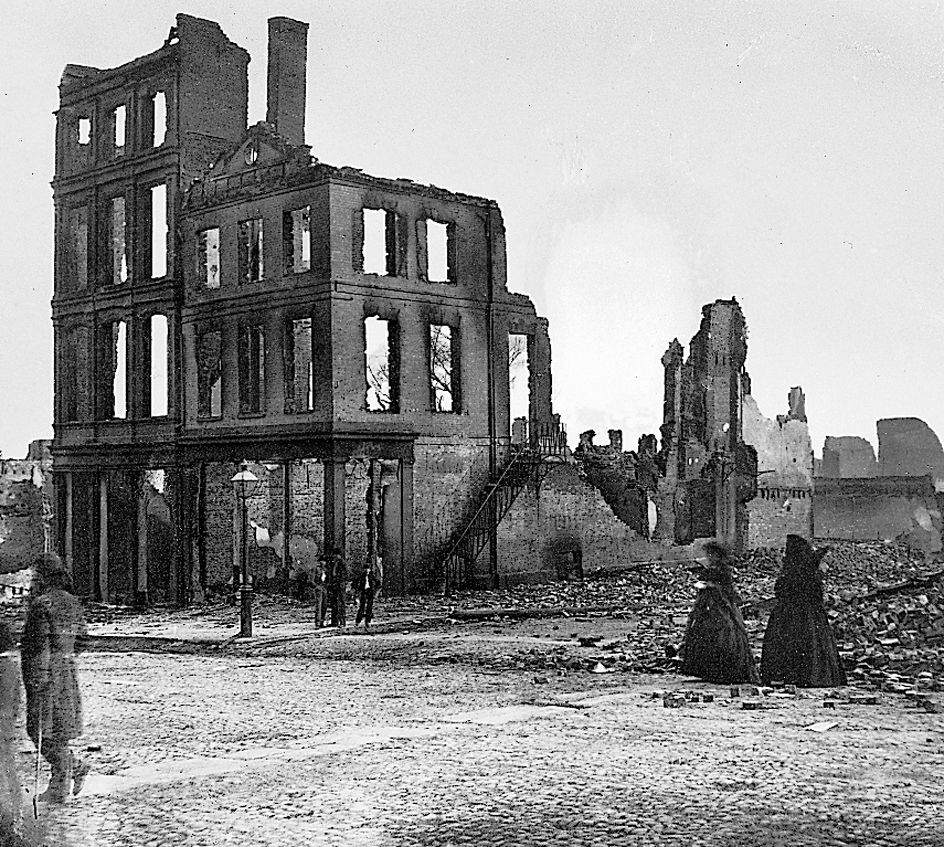
The South won its greatest victories on Virginia battlefields—the first and second battles of Bull Run (also called Manassas), Jackson’s Valley Campaign, and the battles of Fredericksburg and Chancellorsville. More battles were fought in Virginia than in any other state. Union armies repeatedly tried to seize Richmond and the Shenandoah Valley. This fertile valley was called the Granary of the Confederacy. The 1862 battle between the Monitor and the Merrimack (which was renamed the Virginia by the Confederate Navy) at Hampton Roads was the first fight between ironclad warships. This battle marked a turning point in naval warfare.
The Civil War, like the Revolutionary War, ended in Virginia. Lee surrendered to General Ulysses S. Grant at Appomattox on April 9, 1865. 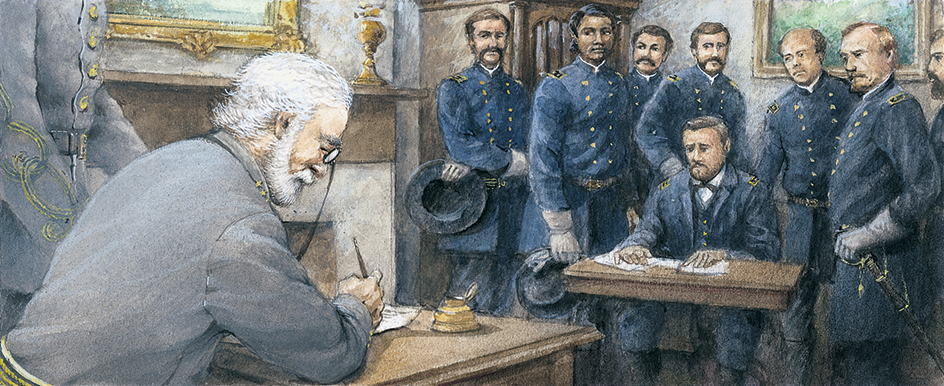
After the war, the federal government passed the Reconstruction Act of 1867, which placed Virginia under army rule as Military District No. 1. This act also provided for a state constitutional convention to draw up a new constitution for Virginia. The constitutional convention, headed by Judge John C. Underwood, met in December 1867. It was controlled by Radical Republicans, and nearly a fourth of its members were Black Americans. A constitution was adopted in 1869. It gave Black citizens the right to vote and provided for a statewide system of public schools. Virginia was readmitted to the Union on Jan. 26, 1870. See Reconstruction.
A major problem facing Virginia after the war was its debt of about $45 million. The state became divided between “funders,” who wanted to pay the debt, and the “readjusters,” who wanted to pay only part of it. The Readjuster Party finally triumphed by bringing about passage of the Riddleberger Act of 1882. The act reduced the state’s share of the debt to about $21 million. Later court decisions assigned $14 million to West Virginia. That state had been part of Virginia when the debt was acquired. See West Virginia (The American Civil War and statehood). After the settlement of the debt issue, the Readjuster Party soon dissolved.
Progress in government and industry.
Modern industry in Virginia began during the early 1880’s, when cigarette factories, cotton textile plants, and shipbuilding plants were built. In 1912, another man born in Virginia, Woodrow Wilson, was elected president. Carter Glass of Lynchburg, then a congressman, became the “father” of the Federal Reserve banking system. 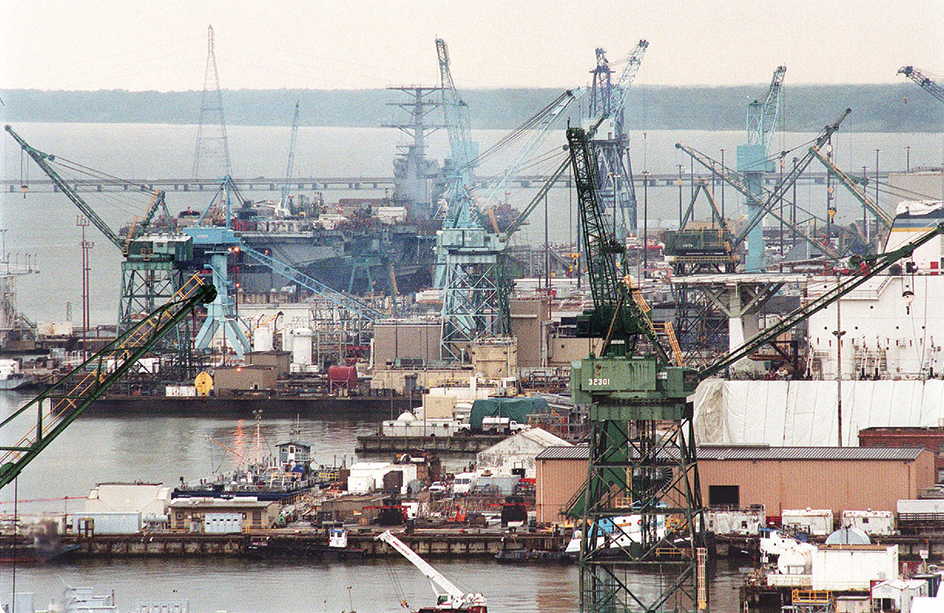
During the early 1900’s, many Virginians moved to other states in search of better job opportunities. More than 400,000 people left the state in the 1920’s.
Harry F. Byrd, Sr., was governor from 1926 to 1930. He used the recommendations of a study commission to reorganize the state government and make it more efficient. In 1933, Byrd was appointed to the U.S. Senate, where he served over 30 years. Throughout this period, Byrd played a leading role in Virginia politics.
The 1930’s were an important period of change in Virginia. Federal government activities in the state during the Great Depression created jobs and helped stop the flow of population from the state. Synthetic textile industries were established in many parts of Virginia.
World War II (1939-1945) brought thousands of servicemen and servicewomen to the Virginia suburbs of Washington, D.C., and to the Norfolk area. Many of these people returned to Virginia to live after the war. During the 1940’s and 1950’s, the state also attracted many other new residents, including federal employees and employees of new industries. By 1955, it had more urban than rural dwellers.
School integration.
Many Virginia communities built new schools during the 1950’s. In the late 1950’s, the issue of school integration became critical.
In 1954, the Supreme Court of the United States ruled that compulsory segregation in public schools was unconstitutional. In 1956, the Virginia legislature passed so-called “massive resistance” laws to close any public school that the federal courts ordered integrated. In 1959, federal and state courts declared these laws invalid. That same year, public schools in Arlington County and Norfolk became the first in Virginia to integrate. But Prince Edward County closed its public schools in 1959 to avoid integration. It reopened the schools in 1964. In the late 1960’s, a series of court decisions speeded up integration in the state.
Continued industrial growth.
Industry continued to expand in Virginia during the 1960’s. The greatest growth occurred in the manufacture of chemicals, clothing, electrical equipment, furniture, and transportation equipment. In 1964, the General Assembly reduced certain taxes to attract new industry.
The $200-million Chesapeake Bay Bridge-Tunnel was completed in 1964. This series of bridges, tunnels, and causeways extends 23 miles (37 kilometers) and links the Norfolk area with the Eastern Shore.
Political changes.
The political life of Virginia changed during the 1960’s. Conservative Democrats, led by U.S. Senator Harry F. Byrd, Sr., had long controlled Virginia politics. But Byrd retired in 1965, and elections became more competitive. In 1966, Virginia voters elected William B. Spong, Jr., a moderate Democrat, to the U.S. Senate. In 1967, William F. Reid became the first African American elected to the state legislature since 1891. The Republican Party also gained strength during the 1960’s. In 1969, A. Linwood Holton, Jr., became the first Republican to be elected governor since 1869. In 1970, voters approved a new state constitution, which took effect in 1971.
Political problems.
During the 1970’s and 1980’s, urban settlement and the location of industries along Chesapeake Bay caused pollution and some damage to plants and wildlife. Efforts to clean the water and to protect the threatened plants and animals were begun.
Virginia, a leading coal-producing state, also was challenged by the reduced use of coal in the United States. This situation developed because of widespread concern over air pollution caused by the burning of coal. Scientists sought ways to reduce the pollution hazard so more coal could be used.
Recent developments.
In 1989, Virginia’s voters elected L. Douglas Wilder governor. Wilder became the first African American ever elected governor of a U.S. state. He served one term, from 1990 to 1994. Under Virginia law, the governor may not serve two terms in a row. 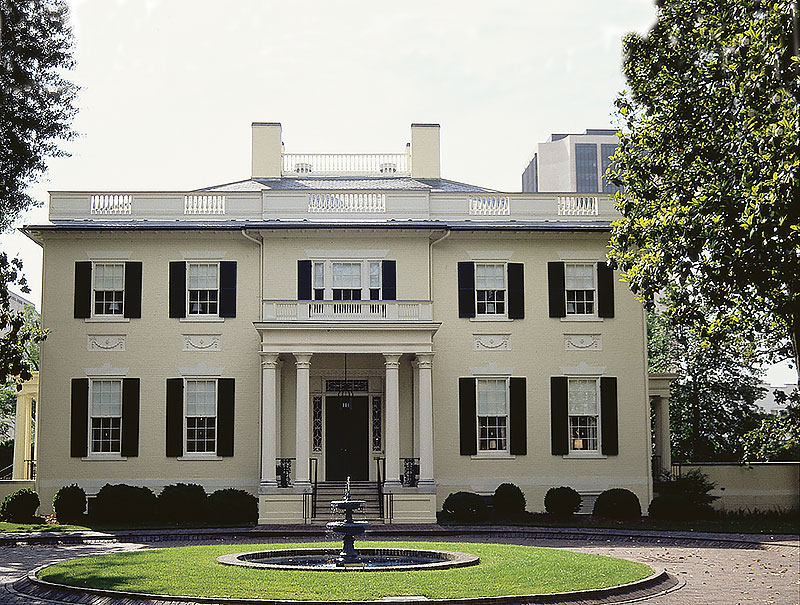
Virginia maintained a strong economy through the end of the 1990’s and into the 2000’s. This is largely because the economy has a broad base. Manufacturing, agriculture, tourism, and activities of the federal government all contribute much to the economy. Virginia’s relatively strong economy has kept its unemployment rate below the national average.
In April 2007, Virginia Polytechnic Institute and State University (Virginia Tech) in Blacksburg was the site of one of the deadliest shootings in U.S. history. A student gunman killed 32 people, including 27 fellow students and 5 teachers, and wounded many more before taking his own life.
In 2014, former Virginia Governor Robert F. McDonnell and his wife Maureen were convicted in federal court of public corruption charges. The charges involved accepting gifts and other benefits in exchange for performing “official acts” in their advocacy for a Richmond businessman. In early 2015, Robert McDonnell was sentenced to two years in prison, and Maureen McDonnell was sentenced to one year and one day in prison. Their lawyers appealed the verdicts, however, and they both remained out of prison. In June 2016, the U.S. Supreme Court—in a unanimous decision—vacated (overruled) the former governor’s conviction. The court ruled that federal prosecutors had too broadly applied an anticorruption statute and that a jury convicted him for conduct that was not, in fact, illegal. In September, prosecutors dismissed all charges against both McDonnells.
In August 2017, a large group of white supremacists (also called white nationalists) gathered in a Charlottesville park to protest the city’s planned removal of a statue of Confederate General Robert E. Lee. Many of those gathered were heavily armed and carried flags with symbols representing Nazism or the Ku Klux Klan—organizations that have carried out race-based terror campaigns against African Americans, Jews, and other minority groups. The white nationalist group was opposed by a counterprotest consisting of students, church groups, and antifascist demonstrators. Numerous skirmishes occurred between the two sides. On August 12, an Ohio man who had marched with the white supremacists drove his car into a crowd of antiracist demonstrators. One woman was killed and many other people were injured. In December 2018, a Virginia jury found the Ohio man, James Alex Fields, guilty of first-degree murder and a number of other charges. He was sentenced to life in prison.
